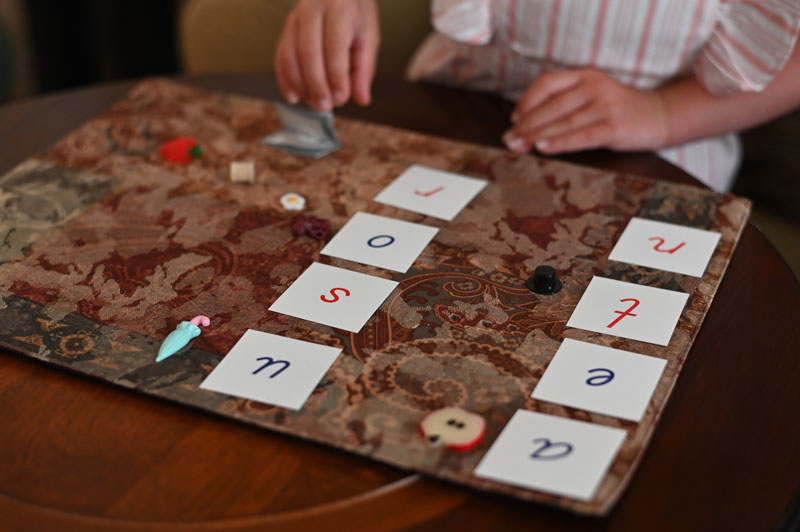The Montessori Movable Alphabet
Learning how to write is a complex process. Just imagine trying to learn how to write in a new language and foreign alphabet. Very few adults attempt such a feat. But that’s exactly what every child does when they are ready to form the written word. Thankfully, the Montessori movable alphabet can help children assimilate language in a fun and accessible way.
It’s amazing how a young child’s absorbent mind soaks up knowledge like a sponge. Although it takes time for children to develop the necessary hand-eye coordination to form letters, the Montessori movable alphabet teaches children how to write in their formative years.

What Is the Montessori Movable Alphabet?
The Montessori movable alphabet consists of a box of 26 wooden letters in alphabetical order. The vowels are blue and the consonants are pink or red to help distinguish the two. The letters help children spell out words so they can eventually learn how to write on paper and read. Like all Montessori materials, the movable alphabet facilitates concrete learning.
Children don’t need to simultaneously learn to write and hold a pencil at the same time. After all, those are two separate skills to master. In order to hold a pencil correctly, children need to develop their fine motor skills. The Montessori movable alphabet is an intuitive approach to writing that helps develop dexterity and hand-eye coordination before a child even attempts to form letters on paper.
Why Maria Montessori Believed Children Should Learn How to Write Before They Read
 It’s a curious thing that Maria Montessori believed children should learn how to write before they attempt to learn how to read. The actual act of reading is passive and doesn’t involve hands-on learning. Dr. Montessori felt that children learned best by working with concrete objects before moving on to a more conceptualized, abstract approach to acquiring knowledge.
It’s a curious thing that Maria Montessori believed children should learn how to write before they attempt to learn how to read. The actual act of reading is passive and doesn’t involve hands-on learning. Dr. Montessori felt that children learned best by working with concrete objects before moving on to a more conceptualized, abstract approach to acquiring knowledge.
In Montessori classrooms, children engage in self-directed learning by using manipulatives to grasp a concept. The movable alphabet takes an abstract concept (in this case, language) and breaks it down into letters children can use to form words. It engages their eyes and hands, creating the type of experience that is essential to the Montessori method. The Montessori By Mom Learning Language Toolbox contains several hands-on materials to aid children in their language development.
How to Know When Your Child Is Ready for the Montessori Movable Alphabet
Children naturally want to communicate through the written word. After all, they come across so many words every day — from books to billboards to milk cartons, words are everywhere. It only makes sense to use the Montessori movable alphabet to bring words into your child’s environment for further exploration.
An easy way to know if your child is ready for the movable alphabet is if they feel confident using sandpaper letters. Like the name implies, Montessori sandpaper letters are textured lower-case and upper-case letters cut out of sandpaper. Your child can practice pre-writing skills by tracing the letters onto paper, a great exercise for tactile learners.
When your child recognizes letters and can connect them to their sounds, they’re ready. Pull out your movable alphabet and set it on a rug for your child to investigate. If your child is interested in the letters, then they’re ready to learn how to use them!
Ways to Foster Your Child’s Desire to Write
Here are a few ways to make the movable alphabet meaningful for your child:
-
- Read to them every day. Point out words while you’re reading.
- Point at objects in their environment and spell them out.
- Place an emphasis on the phonetic sounds of words, pronouncing each sound distinctly.
- Keep paper in your child’s environment and write out words for them to see.
Make sure there is plenty of paper or a writing tablet in your child’s environment to practice squiggles and other random designs. Pay attention to your child’s interest in writing. Never look for perfection in their handwriting or spelling. They’ll get there in time. Praise their efforts and, above all, make it fun.
A Note on Sensitive Periods
If your child is more interested than usual in coloring and making marks on paper, then they may be in a sensitive period. A sensitive period is when a child is developmentally ready to progress in a specific area. They can concentrate intensely and for a long period of time on an activity in their environment. Take advantage of these moments, because they can be fleeting. You might miss an opportunity to help your child learn a new skill.
How to Use the Movable Alphabet
Help your child spell short words. Invite them to scan from left to right to give them a head start on how to write on paper. Invite them to group vowels and consonants. Show them different blends and diagraphs to get them thinking about how letters form words.
You can help them become more familiar with letter recognition by matching the movable alphabet one-to-one with sandpaper letters. They can also match lower-case letters with upper-case letters. These activities will help your child develop dexterity in manipulating small objects. Their fine motor control will improve, and as they learn more words to spell, they will be more motivated to put those words in print.
The movable alphabet pairs perfectly with Montessori language miniatures. Present a few letters of the movable alphabet along with Montessori language miniatures that represent each letter sound. Children can then practice their sound and letter recognition by matching the language miniatures to the corresponding movable alphabet letters.
The Montessori method of teaching children to write will give your child the confidence to progress into more advanced writing skills as they grow. Manipulatives like the movable alphabet help your child assimilate knowledge at an earlier stage because they have concrete objects to work with. Before you know it, your child will transfer their understanding of letter formation onto paper. When they are ready to write, the Montessori movable alphabet is where it all begins.




0 Comments